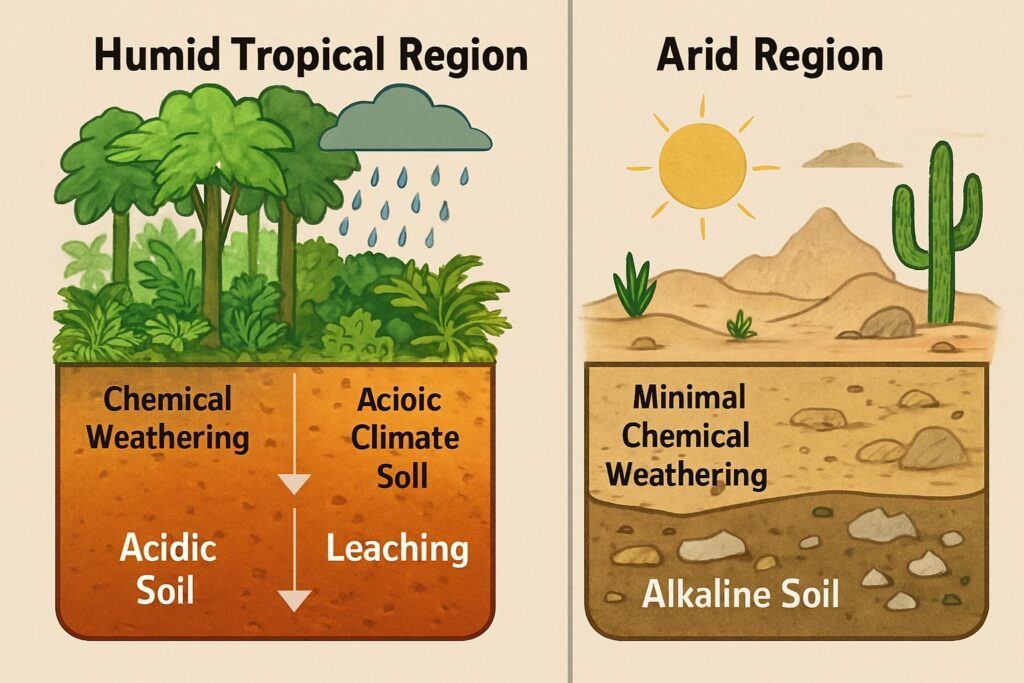The formation of soil or the genesis of soil is a complex process influenced by various geological, climatic, and biological factors over time. Soils are essential for sustaining ecosystems, supporting plant growth, and regulating water cycles. The genesis of soils is driven by physical, chemical, and biological processes that transform parent rock material into fertile soil layers. It is a complex mixture of minerals, organic matter, water, air, and living organisms that make it a unique and diverse ecosystem.

"The genesis of soils refers to the process of soil formation and how it evolved over time."
Factors Influencing Genesis of Soils
1. Parent Material
The parent material is the original rock or mineral that is weathered and transformed into soil. The type of parent material affects the soil’s chemical and physical properties, including its texture, structure, and mineral composition.
2. Climate
Climate plays a crucial role in soil formation and influences the rate and type of weathering processes that occur. For example, in humid tropical regions, the high rainfall rate promotes intense chemical weathering, leading to the formation of highly leached and acidic soils. In arid regions, the limited water availability results in a slow rate of chemical weathering, leading to the formation of more basic and alkaline soils.

3. Relief
Relief refers to the physical features of the land surface, including the slope, aspect, and elevation. Soil formation and development are influenced by relief as it affects the drainage, erosion, and amount of sunlight that the soil receives. For example, soils on a steep slope are more susceptible to erosion, while soils on flat terrain are more susceptible to waterlogging.
4. Time
Time is an essential factor in soil formation as it allows the physical and chemical weathering processes to occur and the soil to develop. Soils in regions with a longer geological history tend to be more developed and mature than those in regions with a shorter geological history.
Table of Contents
Stages in Genesis of Soils
Weathering
Weathering refers to the physical and chemical processes that break down the parent material and form soil. Physical weathering occurs through processes such as abrasion, and root wedging, while chemical weathering occurs through processes such as hydrolysis, oxidation, and carbonation.

Leaching
Leaching refers to the process of water moving through the soil, dissolving and removing minerals and other substances. This process can result in a reduction of soil fertility, especially in regions with high rainfall, as essential plant nutrients are removed.
Horizon Development
Horizon development refers to the formation of soil layers, known as horizons, as a result of weathering and leaching. The O horizon is the topmost layer, composed of organic matter, while the A horizon is the next layer and is composed of mineral soil that is rich in organic matter and has a dark color. The B horizon is a subsoil layer that is less rich in organic matter and has a lighter color. The C horizon is the parent material layer, composed of weathered rock.

Soil Profile Development
Soil profile development refers to the vertical arrangement of horizons within the soil, which provides a comprehensive understanding of the soil’s characteristics and evolution. The depth of the soil profile, the thickness of each horizon, and the type of parent material are all critical factors in determining soil profile development.

Classification of Soils
Soil classification is the systematic categorization of soils based on their physical, chemical, and biological properties. This classification helps in understanding soil behavior, fertility, and suitability for various land uses such as agriculture, construction, and environmental conservation.
1. Based on Origin and Composition
- Residual Soils: Formed in situ from the weathering of parent rock. They remain at the place of origin.
- Transported Soils: Carried and deposited by natural agents like water (alluvial), wind (aeolian), glaciers (glacial), or gravity (colluvial).
2. Based on Texture
- Sandy Soils: Coarse texture, good drainage, low fertility.
- Clayey Soils: Fine particles, poor drainage, high water retention.
- Loamy Soils: Balanced mix of sand, silt, and clay; ideal for cultivation.

Types of Soil based on Water Retention
3. Based on Soil Horizon Development
- Zonal Soils: Well-developed soil horizons influenced by climate and vegetation (e.g., laterite, chernozem).
- Intrazonal Soils: Dominated by local factors like topography or parent material (e.g., saline soils).
- Azonal Soils: Poorly developed profiles, often young (e.g., alluvial and lithosols).
4. Based on Indian Soil Classification (ICAR)
In the Indian context, soils are classified into the following major types:
- Alluvial Soil – Fertile and found in river plains (e.g., Indo-Gangetic plain).
- Black Soil – Rich in clay, moisture-retentive; ideal for cotton (Deccan plateau).
- Red Soil – Poor in nitrogen, found in southern and eastern India.
- Laterite Soil – Found in tropical areas with heavy rainfall; acidic and low fertility.
- Mountain Soil – Found in hilly regions; varies with altitude.
- Desert Soil – Sandy, low moisture; found in arid regions like Rajasthan.
- Peaty and Marshy Soil – Rich in organic matter, found in waterlogged areas.
Soil Conservation and Management
Human activities, such as deforestation, intensive agriculture, and overgrazing, can have a significant impact on soil formation and fertility. Therefore, it is important to understand the processes of soil formation and the factors that influence it to implement effective conservation and management practices.
Soil conservation practices, such as cover cropping, mulching, and reduced tillage, can help to protect soil structure and fertility. Additionally, soil management practices, such as the use of organic fertilizers and the rotation of crops, can help to maintain soil fertility and prevent soil degradation.
Conclusion
In conclusion, the genesis of soils is a complex and dynamic process that is influenced by various factors, including parent material, climate, relief, and time. Understanding the process of soil formation is essential for effective soil conservation and management and to maintain the soil’s fertility and productivity. By implementing appropriate conservation and management practices, we can protect this valuable resource and ensure its continued productivity for future generations.
